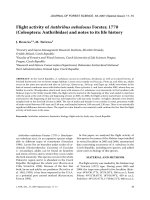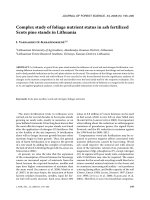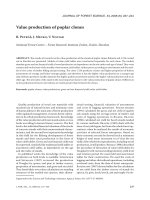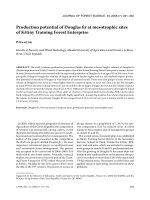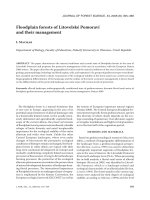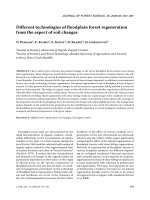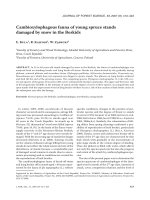Báo cáo lâm nghiệp: "DNA-based control of oak wood geographic origin in the context of the cooperage industry" ppsx
Bạn đang xem bản rút gọn của tài liệu. Xem và tải ngay bản đầy đủ của tài liệu tại đây (283.49 KB, 8 trang )
97
Ann. For. Sci. 61 (2004) 97–104
© INRA, EDP Sciences, 2004
DOI: 10.1051/forest:2003089
Original article
DNA-based control of oak wood geographic origin in the context
of the cooperage industry
Marie-France DEGUILLOUX
a,b
, Marie-Hélène PEMONGE
a
, Rémy J. PETIT
b
*
a
Institut National de la Recherche Agronomique, Unité de Recherches Forestières, Équipe de Génétique des Arbres Forestiers,
69 Route d’Arcachon, 33612 Cestas Cedex, France
b
Centre Technique du Bois et de l’Ameublement, 10 avenue de St-Mandé, 75012 Paris, France
(Received 18 September 2002; accepted 20 May 2003)
Abstract – The recent growth of the French barrel industry, leading to increased importations of oak wood and a general lack of wood origin
guarantee, has resulted in the demand for a reliable technique permitting to control the provenance of oak wood. In this study we propose to
adapt wood traceability technique using chloroplast DNA markers to this industrial context. The retrieval of DNA and haplotype determination
has been tested on different types of wood samples that can be collected in cooperage firms, and a clear effect of wood treatment on DNA
degradation has been observed. Despite the poor quantity and quality of DNA retrieved from staves, haplotypes could be determined on a large
proportion of the samples, permitting to check the genetic conformity of woods with announced provenances. In several cases, our study proved
the existence of unlabeled oak woods originating from eastern Europe and the incorrect use of the names of famous French forests.
chloroplast DNA / diversity / haplotype / Quercus / traceability
Résumé – Contrôle de l’origine géographique des bois de chêne utilisés en tonnellerie. L’importation croissante de bois de chêne et le
manque de garantie sur son origine, liés à l’expansion récente de la tonnellerie française, rendent nécessaire la mise au point d’une technique
fiable permettant de contrôler l’origine des bois de chêne. Dans cette étude, nous avons cherché à adapter, pour ce secteur industriel, les
méthodes moléculaires de traçabilité des bois de chêne utilisant les marqueurs chloroplastiques. La qualité et la quantité de l’ADN extrait et la
caractérisation des haplotypes ont alors été évalués sur les différents types d’échantillons de bois rencontrés dans les tonnelleries. Nous avons
pu démontrer un effet net des différents traitements du bois sur la dégradation de l’ADN. Cependant, malgré la faible qualité et quantité d’ADN
extrait des bois de merrains, les haplotypes ont pu être déterminés sur une large proportion des échantillons, permettant de tester la conformité
des bois avec l’origine annoncée. Dans plusieurs cas, nous avons pu mettre en évidence l’existence de bois mal identifiés, provenant de l'est de
l'Europe, ainsi que l’utilisation abusive des noms des provenances françaises renommées.
ADN chloroplastique / diversité / haplotype / Quercus / traçabilité
1. INTRODUCTION
Decades ago winemakers discovered that certain wines
benefited from storage in oak barrels [2, 18]. The barrel essen-
tially does two things: it allows a very slow introduction of
oxygen into the wine, and it imparts the character of the wood
into the wine by leaching of extractives. In this way, wine goes
through subtle chemical changes, resulting in greater com-
plexity and a softening of the harsh tannins and flavours
present at the end of fermentation. Only European pedunculate
and sessile oaks (respectively Quercus robur L. and Quercus
petraea (Matt.) Liebl.), as well as American white oaks (espe-
cially Quercus alba L.), satisfy the requirements of porosity,
strength and flavour to be imparted to the finished wine.
Recent growth, investment and modernization in the wine and
spirit industry have created a great demand for oak logs or
staves (i.e. the narrow strips of wood used to make up the barrel).
The cooperage market is currently the most profitable mar-
ket for oak wood in France, with a growth rate of 15% per year
and up to 200 000 m
3
of oak wood removed per year for a total
of 400 000 barrels produced (data communicated by the
Fédération Française de Tonnellerie). Much of the wood used
by the French barrel industry still originates from France.
Oaks (especially Q. robur and Q. petraea) are indeed the most
abundant tree species in the French forests, which cover some
27% of the land, and the quality of French oak is a renowned
standard. However, the recent growth of the barrel industry
has forced French coopers to import significant amounts of oak
wood, either from eastern European countries (mostly Q. robur)
or from the United States (for Quercus alba). Consequently,
*
Corresponding author:
98 M.F. Deguilloux et al.
the effect of the geographic origin of oak wood on wines is the
subject of many discussions and experimentations throughout
the world [10, 13, 14], along with the influence of barrel mak-
ing process itself on wine (i.e. open-air drying of staves, wood
toasting) [3, 6, 9, 10, 15, 17, 19, 20]. Another consequence of
the diversification of oak wood origins is the need for clear
provenance identification.
The recent trade of oak wood between eastern European
countries, United States and France has developed because of
an increased demand from the cooperage industry and because
of differences in price. In this context, the origin of oak wood
is difficult to guarantee, especially within Europe, since the
same species are found throughout much of the continent
(Q. petraea and especially Q. robur). In particular, the lack of
clear identification of provenances during transactions, cou-
pled with the variable but often high number of intermediaries
between the oak forest and the cooper, are often reported. This
results in a demand from the cooper industry for a reliable
technique permitting to control the provenance of oak wood.
The ultimate rationale for an improved “traceability” is the
respect of prices and should eventually benefit to foresters pro-
ducing high quality oak wood in sustainably managed forests.
Previous research indicates that maternally inherited DNA
markers located in the oak chloroplast genome should be able
to meet some of the expectations for traceability in this indus-
try, provided DNA could be retrieved from dry wood. Meth-
ods comparing strontium isotopes ratios have also been pro-
posed to identify logs of spruce or fir from different sites [8].
Because these approaches, although encouraging, are limited
by the fact that such markers can differ between individuals
from the same population or even between different tissues
from the same individual [11], we have started to explore the
possibilities of genetic markers.
We recently developed a wood traceability technique using
chloroplast DNA markers in European oaks [5]. In particular,
we first demonstrated the possibility to recover and analyse
DNA from dry wood [4, 7]. The next step consisted in a trans-
position of the characterisation of chloroplast variants (i.e.
haplotype) from DNA isolated from fresh samples onto DNA
isolated using dry wood samples; such variants can be used to
differentiate oak wood lots originating from western versus
eastern Europe [5]. Chloroplast (cp) DNA lineages have been
previously identified and mapped in European oaks [16]. For
the most part, their distribution was established during post-
glacial expansion of oaks from distinct refugia, after the last
ice age (approximately 18 000 years before Present). Different
recolonisation routes involving different European refugia
resulted in a clear geographical structure of cpDNA haplo-
types. This strong structure, uncovered by mapping the
cpDNA genetic structure at over 2600 localities, can be used
for traceability purposes. In fact, oak stands often possess only
one haplotype, so that conformity tests of oak products with
their announced origin are considerably facilitated.
Here this method is adapted to the case of the French coop-
erage industry, to help coopers check the conformity of oak
wood lots. The retrieval of DNA and haplotype determination
has been tested on wood samples collected in several cooperage
firms. We tested the complete traceability technique on all types
of wood samples that might be used for provenance control in
this industry. Tests were conducted on green staves seasoned
less than one year outdoors, seasoned staves entering in the
manufacture chain (after two years of open-air drying), and
staves collected from finished barrels (i.e. staves that have fol-
lowed the entire manufacture chain, including the toasting
step). The feasibility of DNA analysis on those different types
of samples is compared and a global traceability process
adapted to the context of cooperage is proposed.
2. MATERIALS AND METHODS
2.1. Wood material
A total of 131 oak wood samples (Q. robur and Q. petraea) were
collected in ten different French cooperage makers, corresponding to
three steps of barrels making (green, dry or barrel staves, Tab. I). In
five firms, green and/or dry staves were collected in open-air wood
stocks (firms A-B-C-D-E), whereas in five other firms dry staves
were collected at the beginning of the barrel making process (firms F-
G-H-I-J). Note however that the samples are not necessarily repre-
sentative of wood diversity in those firms. In total, tests were con-
ducted on 56 green staves and nine logs seasoned less than one year
outside, 36 seasoned staves entering in the manufacture chain (after
two years of open-air drying) and 30 staves collected from a single
finished barrel (Tab. I). The assumed provenances of all wood sam-
ples were provided by the cooperages before analysis, provenance
information ranging from the European region to the stand. Among
the 56 green staves, 17 had been prepared from the nine logs, in order
to check the conformity of the haplotypes revealed when different
parts of a log are used for analysis. These were labelled “Green a-i”
(for the staves) and “GreenLog a-i” (for the logs). The barrel investi-
gated was prepared specifically for this study. It was made up of
staves originating from various regions in France and from different
countries (Tab. I). The information about the staves used to make the
barrel was kept secret until the analysis was completed, in order to
check the validity of the procedure.
2.2. DNA isolation and amplification
A little piece of wood was sawn from each stave and used for
DNA isolation. All wood DNA isolation procedures were carried out
under sterile conditions in separate dedicated rooms, as described in
Deguilloux et al. [4]. The procedure first included cleaning with
diluted bleach and suppression of surface tissues of wood fragments.
Then, less than 100 mg of wood shavings was obtained with a scalpel
from internal parts of samples, or parts that were not directly toasted
in the case of staves obtained from the barrel (at each extremity of the
staves). Those shavings were then ground into a fine powder using a
Retsch-mill apparatus (Fischer-Bioblock) and used for genomic
DNA isolation with the DNeasy Plant minikit (Qiagen). During each
isolation manipulation, several negative controls (treated in the same
way than the normal samples except that no sample sawdust was
added) were used in order to check for potential contamination.
The amplification of 11 different cpDNA fragments, allowing the
haplotype characterisation of wood samples (Tab. II), was performed
according to Deguilloux et al. [5]. Three different sets of fragments
were used to characterize chloroplast variants: the combination I
(involving three longer fragments easier to score: d1t1, d7t7 and t4f4)
was used for haplotype determination on green wood samples, the
combination II (involving three shorter fragments easier to amplify
on degraded DNA: dt12b, dt72 and tf42) was developed for drier
wood; and finally the combination III (involving five even shorter
fragments: dt14, µdt1, dt73, dt74 and tf42) was used for staves
Molecular control of cooperage wood origin 99
Table I. Type, provenance, haplotype and conformity with announced origin of analysed staves.
Sample Type of stave Cooperage
Announced
provenance
Provenance
information type
Haplotype
Conformity with
provenance haplotypes
Green 1 green stave A Vo s g e s region b yes
Green 2 green stave A Vo s g e s region c-d yes
Green 3 green stave A Vo s g e s region e yes
Green 4 green stave A Vo s g e s region c yes
Green 5 green stave A Vo s g e s region d yes
Green 6 green stave A Vo s g e s region b yes
Green 7 green stave A Vo s g e s region b yes
Green 8 green stave A Vo s g e s region b yes
Green 9 green stave A Vo s g e s region b yes
Green 10 green stave A Nevers region c yes
Green 11 green stave A Nevers region b yes
Green 12 green stave A Nevers region b yes
Green 13 green stave A Vo s g e s region b yes
Green 14 green stave A Vo s g e s region b yes
Green 15 green stave A Vo s g e s region b yes
Green 16 green stave A Vo s g e s region – –
Green 17 green stave A Vo s g e s region b yes
Green 18 green stave A Vo s g e s region b yes
Green 19 green stave A Nevers sub-region b yes
Green 20 green stave A Nevers sub-region b yes
Green 21 green stave A Nevers sub-region c yes
Green 22 green stave A Tronçais stand b no
Green 23 green stave A Tronçais stand b no
Green 24 green stave A Tronçais stand c yes
Green 25 green stave A Vo s g e s region b yes
Green 26 green stave A Vo s g e s region b yes
Green 27 green stave A Vo s g e s region b yes
Green 28 green stave A Vo s g e s region – –
Green 29 green stave A Vo s g e s region b yes
Green 30 green stave A Vo s g e s region – –
Green 31 green stave A Vo s g e s region b yes
Green 32 green stave A Centre region a –
Green 33 green stave A Centre region b yes
Green 34 green stave A Vo s g e s region b yes
Green 35 green stave A Vo s g e s region b yes
Green 36 green stave A Vo s g e s region b yes
Green 37 green stave A Vo s g e s region b yes
Green 38 green stave A Centre region b yes
Green 39 green stave B Jupilles stand b no
Green Log a green log B Jupilles stand b no
Green a green stave B Jupilles stand b no
Green a' green stave B Jupilles stand b no
Green Log b green log B Haguenau stand b yes
Green b green stave B Haguenau stand b yes
Green b' green stave B Haguenau stand b yes
Green Log c green log B Tronçais stand b no
Green c green stave B Tronçais stand b no
Green c' green stave B Tronçais stand b no
Green Log d green log B Oison stand f no
Green d green stave B Oison stand f no
Green d' green stave B Oison stand f no
Green Log e green log B Haute Saône region b yes
Green e green stave B Haute Saône region b yes
Green e' green stave B Haute Saône region b yes
Green Log f green log B Jupilles stand b no
Green f green stave B Jupilles stand b no
Green f' green stave B Jupilles stand b no
Green Log g green log B Lunéville stand b yes
Green g green stave B Lunéville stand b yes
Green g' green stave B Lunéville stand b yes
Green Log h green log B Nièvre region b yes
Green h green stave B Nièvre region b yes
Green h' green stave B Nièvre region b yes
Green Log i green log B Fontainebleau stand c yes
100 M.F. Deguilloux et al.
Table I. Continued.
Sample Type of stave Cooperage
Announced
provenance
Provenance
information type
Haplotype
Conformity with
provenance haplotypes
Green i green stave B Fontainebleau stand – –
Dry 1 dry stave E Tronçais stand c yes
Dry 2 dry stave E ? d –
Dry 3 dry stave E Vos g e s region a yes
Dry 4 dry stave C Pyrenees region c yes
Dry 5 dry stave D Alsace region h no
Dry 6 dry stave C Nevers region c yes
Dry 7 dry stave L Poland country h yes
Dry 8 dry stave C eastern Europe European region h yes
Dry 9 dry stave D Vo s g e s region b yes
Dry 10 dry stave D Nièvre region b yes
Dry 11 dry stave C Vos g e s region a yes
Dry 12 dry stave C ? a –
Dry 13 dry stave C Pyrenees region c yes
Dry 14 dry stave H Vo s g e s region c yes
Dry 15 dry stave H Vo s g e s region c yes
Dry 16 dry stave H Vo s g e s region c yes
Dry 17 dry stave H Vo s g e s region c yes
Dry 18 dry stave D Allier region c yes
Dry 19 dry stave D Allier region c-e yes
Dry 20 dry stave G Vo s g e s region b yes
Dry 21 dry stave G Vo s g e s region d yes
Dry 22 dry stave G Vo s g e s region b yes
Dry 23 dry stave G Vo s g e s region b yes
Dry 24 dry stave I Vo s g e s region c yes
Dry 25 dry stave I Vo s g e s region c yes
Dry 26 dry stave I Vo s g e s region c yes
Dry 27 dry stave I Vo s g e s region c yes
Dry 28 dry stave J Centre region d yes
Dry 29 dry stave J Centre region c yes
Dry 30 dry stave J Centre region d yes
Dry 31 dry stave J Centre region c yes
Dry 32 dry stave F Vezelay sub-region d yes
Dry 33 dry stave F Vezelay sub-region e yes
Dry 34 dry stave F Vezelay sub-region d yes
Dry 35 dry stave F Vezelay sub-region – –
Dry 36 dry stave F Vezelay sub-region b yes
Barrel 1 barrel stave K Tronçais stand c yes
Barrel 2 barrel stave K Tronçais stand c yes
Barrel 3 barrel stave K Tronçais stand a no
Barrel 4 barrel stave K Nevers sub-region e yes
Barrel 5 barrel stave K Nevers sub-region c-e yes
Barrel 6 barrel stave K Nevers sub-region d yes
Barrel 7 barrel stave K Vo s g e s region a yes
Barrel 8 barrel stave K Vo s g e s region b yes
Barrel 9 barrel stave K Vo s g e s region f-g-h no
Barrel 10 barrel stave K Centre France region a-c-e-f-g-h yes
Barrel 11 barrel stave K Centre France region e yes
Barrel 12 barrel stave K Centre France region e yes
Barrel 13 barrel stave K Allier region c-e yes
Barrel 14 barrel stave K Allier region c yes
Barrel 15 barrel stave K Allier region c-e yes
Barrel 16 barrel stave K Slovakia country f yes
Barrel 17 barrel stave K Slovakia country f yes
Barrel 18 barrel stave K Slovakia country – –
Barrel 19 barrel stave K Czech Republic country a-c-e-f-g-h yes
Barrel 20 barrel stave K Czech Republic country f-g-h yes
Barrel 21 barrel stave K Czech Republic country a-f-g-h yes
Barrel 22 barrel stave K Russia country – –
Barrel 23 barrel stave K Russia country a-d-e-f-g-h-i yes
Barrel 24 barrel stave K Russia country – –
Barrel 25 barrel stave K Ukrainia country f-g-h yes
Barrel 26 barrel stave K Ukrainia country f yes
Barrel 27 barrel stave K Ukrainia country b no
Barrel 28 barrel stave K United states country – –
Barrel 29 barrel stave K United states country – –
Barrel 30 barrel stave K United states country – –
Molecular control of cooperage wood origin 101
obtained from the barrel. The set of five chloroplast fragments, dt13
and µdt1 (instead of dt12b), dt73 and dt74 (instead of dt72) and tf42,
each containing a single informative polymorphism, permits the same
haplotype distinction but with the analysis of shorter fragments. The
adaptation of genetic analyses to wood samples, including the neces-
sity to amplify very small fragments for increasingly degraded wood,
as well as the haplotype characterisation based on the combination of
several PCR-RFLP analyses, are described in Deguilloux et al. [5].
Each amplification experiment included both DNA isolation controls
and PCR controls. Seven of the cpDNA fragments were digested by
restriction endonucleases: d7t7, dt72, dt73 and dt74 fragments with
MseI, d1t1, dt12b and dt13 with TaqI, whereas others were analysed
directly after PCR. Digestion controls (digestion of DNA isolated
from fresh buds) were included in the experiment to check the diges-
tion and to compare wood DNA digestion products with those of
known haplotypes. PCR and digestion products were checked on 8%
polyacrylamide gel followed by ethidium bromide staining and visu-
alised under UV light, whereas the chloroplast microsatellite µdt1
was resolved on a Li-Cor model 4000L automatic DNA sequencer.
2.3. Test of conformity of origin
The use of the statistical procedure developed by Deguilloux et al.
[4] allowed us to test if the combination of haplotypes found in the
11 wood lots analysed in this study were conforming to a French origin.
Each wood lot corresponded to all wood samples originating from
one particular cooperage industry. Wood samples of known foreign
origin were therefore included in some of these lots, purely for dem-
onstration and illustration purposes. In particular, the last lot corre-
sponded to the “international” barrel. We define a null hypothesis H
o
:
the wood lot is in fact of French origin. The number of samples from
the wood lot that have been typed is called N. For each haplotype i
identified in the tested lot, p(i) denotes its frequency in the region of
alleged origin (France in our case). We state that: if p(i) < 0.05, then
P(i) =
1 – [1–p(i)]
N
, if p(i) ≥ 0.05, then P(i) = 1.
The probability P to observe the particular configuration of haplo-
types in the sample is given by the product of all P(i): .
If P < S we will reject the hypothesis H
o
(and declare that the lot is
non-conform) with a risk α≤ S, whereas if P ≥ S we cannot reject the
hypothesis of conformity. Although the procedure can help decide
that a given lot is not conform (with an estimated risk that must be
assumed), we can in no way decide that it is conform, since we are
unable to evaluate the corresponding risk (i.e. the risk to declare that
the lot is conform when it is in fact non-conform).
3. RESULTS
3.1. DNA amplification – genotyping
The design of specific primers, amplifying fragments of
various lengths, allowed us to obtain good amplification suc-
cess rates on most types of samples (Fig. 1). Relatively long
fragments could be amplified on DNA isolated from fresh oak
wood, with success rates ranging from 78 to 93%, whereas
shorter fragments were amplified on DNA isolated from dry
Table II. Primer pairs used for haplotype characterisation.
Primer pair
Primers
combination
Sequence 5’–3’ Primer
Fragment length
(bp)
Annealing
temperature
d1t1 I GAGACCAGAAAGGGTAATGA d1 350 49 °C
CTAAATAGCAACGCAAGAAA t1
d7t7 I GATCAATTCAATTAGGGTCG d7 167 52 °C
ATAT CT TATGC AC ATG GT GG t7
t4f4 I AGCTGTTCTAACAAGTGGGG t4 269 47 °C
GGACTCTATCTTTATTCTCG f4
dt12b II GAGACCAGAAAGGGTAATGAA dt12bu 175 50 °C
TTTCAATAACTTGTTGATCC dt12bl
dt72 II GCGTTGCTATTTAGTAAATCC dt72u 113 50 °C
GTGGACCATTCAGGAACGAGA dt72l
tf42 II TAATGACGACCCGAATCTTTA tf42u 69 45 °C
ACAACAACTCTTTCGATTTTT tf42l
µdt1 III ATCTTACACTAAGCTCGGAA µdt1u 87 48 °C
TTCAATAACTTGTTGATCCC µdt1l
dt13 III GAGACCAGAAAGGGTAATGAA dt13u 53 50 °C
GAATCAATGAATGAAAGTGGA dt13l
dt73 III GCGTTGCTATTTAGTAAATCC dt73u 69 45 °C
AGAGTAAACTAGTGATTATGG dt73l
dt74 III CCATAATCACTAGTTTACTCT dt74u 65 45 °C
GTGGACCATTCAGGAACGAGA dt74l
dt73b III GCGTTGCTATTTAGTAAATCC dt73bu 62 45 °C
ACTAGTGATTATGGGTAAACC dt73bl
dt74b III TTTACTCTATACTCACTAGAG dt74bu 52 45 °C
GTGGACCATTCAGGAACGAGA dt74bl
P Pi()
i
∏
=
102 M.F. Deguilloux et al.
oak wood with success rates ranging from 58 to 91%. Finally,
no fragment longer than 90 bp could be amplified on DNA iso-
lated from barrel staves; with the shortest fragments the suc-
cess rates ranged from 37 to 97%. Amplification success was
strongly dependent on the primer pairs used. The lowest suc-
cess rates were for the fragments µdt1 (87 bp), dt73 (69 bp)
and dt74 (65 bp) on barrel staves’ DNA.
Whereas an important proportion of drying wood DNA
could be genotyped with the PCR-RFLP combination I (i.e.
with the longer fragments) (more than 86% of samples geno-
typed), shorter fragments were necessary to type dry wood
DNA (Fig. 2). The best genotyping rates on every type of sam-
ples was obtained with combination III, with 96.2% of green
staves and 95.6% of dry staves genotyped, compared to only
46.7% of the staves coming from the barrel.
In all cases, the same genotype was found with staves and
logs corresponding to the same tree (Tab. I), confirming the
relevance of the technique and the absence of contamination
between samples or of contamination by external DNA. More-
over, all isolation and PCR controls remained negative.
3.2. Haplotype conformity with putative provenance
Over the 77 green woods genotyped, only nine staves and
four logs, corresponding to five oak trees, had haplotypes that
were not consistent with the provenance announced by the
coopers (Tab. I). This involved four cases where the haplo-
types revealed from the wood samples had not been identified
in previous samples from the corresponding stand (prove-
nances Tronçais and Jupilles) and one case where the haplo-
type characterised had never been detected in native oak mate-
rial from France (haplotype f characterised on staves Green d-
d’). Indeed, haplotype f is widely distributed in central and
eastern Europe, from Italy and Germany to Russia, but is not
considered native in France (this haplotype had been detected
so far in only two other French populations over 743 popula-
tions analysed, at low frequency, and probably on introduced
material [16]). Similarly, only one dry stave had a haplotype
that was not consistent with its region of origin. Indeed, this
sample (Dry 5) had haplotype h, never found so far in Alsace
but widespread in Europe, especially from Hungary to Russia.
For the barrel, three staves, among the 14 that could be gen-
otyped, were not consistent with the origin of the wood lot
used. These analyses were repeated subsequently for these
three staves and the typing was fully confirmed. In one case
(stave Barrel 3), the haplotype characterised is not known from
the stand from where the wood used to make the barrel was
thought to originate, whereas in the second case (stave Barrel 9),
the sample was only partly genotyped, but all possible haplo-
types (f, g or h) have never been detected so far from Alsace,
but are widespread in the central and eastern part of the conti-
nent. In the last case, a stave (Barrel 27) considered to originate
from Ukrainia had a western European haplotype (haplotype b,
which has never been found that far eastwards [16]).
3.3. Test of conformity of origin
Over the 11 wood lots considered, four were declared non-
consistent with a French origin at the 5% threshold and two at
the 1% threshold (Tab. III). This included lots from which
characterised haplotypes are nearly absent from France (see
last paragraph) as well as the barrel itself (made-up of several
provenances, including some non-French ones).
4. DISCUSSION
The genetic methods designed for haplotype characterisa-
tion [5] proved to be relevant for woods used in the French
barrel industry. Primer efficiency was very heterogeneous. In
particular, it was clear that the shorter fragments did not
always yield the best amplification rates, even though size
played a large role. Indeed, the regions flanking informative
polymorphisms are not always well suited for primer design,
as in the case of fragment dt73, for which the formation of a
dimer resulted in low amplification rates. In such cases, shift-
ing primer position by a few nucleotides may make a large dif-
ference, as shown in Deguilloux et al. [5]. Nevertheless, it is
now possible to characterise chloroplast haplotypes with a
high success rate (over 95%) on both green and dry oak staves,
using those primers amplifying the shortest DNA fragments.
Figure 1. Amplification success rates of different chloroplast frag-
ments over the 77 oak wood samples.
Figure 2. Proportion of green, dry and barrel staves genotyped with
the PCR-RFLP combinations I, II or III.
Molecular control of cooperage wood origin 103
Better amplification success rates and longer fragments
could be obtained for green staves, compared to dry or toasted
ones: clearly, the various treatments necessary to obtain the bar-
rels alter the quality of the DNA present in the wood. In the
cooperage industry, the traditional method to dry staves con-
sists in storing the wood outdoors, generally up to two years.
The wood humidity goes down from 60–75% to 12–18%.
Because this is a slow process, the risk of appearance of fissures
in the staves is reduced [19]. As a consequence, however, the
wood remains humid and exposed to oxygen and UV rays for
a very long period, three factors that are known to affect DNA
conservation [12]. Fortunately, although humidity favours the
development of the microflora on the surfaces of the staves,
fungi are reported to colonize only superficial layers of the
wood [3, 20], which should restrict DNA degradation. On the
other hand, during drying, oak wood undergoes a slow chem-
ical and biochemical transformation, leading to the concentra-
tion of wood extractives [1]. A strong decline in the level of
water-soluble ellagitanins has been reported in oaks staves, as
part of these compounds is leached out by rainwater and another
part is transformed by hydrolysis or oxidation into insoluble
polymers [6]. Consequently, the open-air drying process results
not only in highly degraded DNA but also in the apparition of
molecules inhibiting genetic analyses (mainly PCR). Finally,
during barrel making, the central parts of the staves are heated
so that they can be shaped without splitting, and can release
interesting extractible compounds in spirits. The heating of
wood at a temperature up to 180 °C must further degrade DNA
remains, leading to poorer haplotype determination rate on
toasted staves compared to dried staves.
Despite these degradations of the DNA in oak staves, the
adaptation of genetic analyses allowed us to determine the chlo-
roplast haplotype in most cases. A reliable procedure can now
be proposed to coopers, which permits to check the genetic con-
formity of oak wood with the announced provenance. Indeed,
the comparison of chloroplast haplotypes identified on dry staves
with that from fresh material directly sampled in the region of
origin (by relying on previous studies of chloroplast DNA var-
iability in Europe [16]) or in the stand itself, can be performed.
The procedure could be improved by a more complete typing
of cpDNA haplotypes. Indeed, the typing is still incomplete for
haplotypes absent or very rare in France. The detection of new
polymorphisms permitting to distinguish exotic haplotypes
may be particularly worthwhile, as it would allow excluding
more readily a given provenance. In any case, if precise infor-
mation is provided on wood origin, and the area where the logs
should have been collected is more precisely circumscribed,
cases of non-conformity will be easier to identify with the
genetic test. This is reflected in this study, where cases of non-
conformity often included samples claimed to originate from
specific stands. In these cases, only one or two haplotypes are
expected, providing a higher exclusion power (by comparison,
up to four or five different haplotypes can be expected from a
given French “region”). However, according to our experience,
wood provenance information is often vague, from the region
to the country level. Additionally, there are also problems with
provenance denomination, as the names used by coopers to
identify regions often do not correspond to administrative ones.
Genetic analyses allowed us to check the genetic conformity
between oak wood and claimed geographic origin, and can now
be used in the barrel industry. Our first results proved the exist-
ence of unlabeled woods from eastern Europe and sold as
French woods. Furthermore, wood suppliers appear to use the
names of famous forests (such as Tronçais or Jupilles) in an
improper way (for wood originating from other forests, regions,
or countries). Our procedure could be used to protect the barrel
industry from those abuses.
Provided precautions are taken against DNA contamina-
tions during all analyses, haplotype determination on oak
staves is possible. The procedure proposed should include the
analysis of at least eight staves collected in the wood stock of
a cooperage (staves collected during the drying process rather
than toasted ones). This number (eight samples) allows the
rejection of French origin from 4.6% of simulated French lots
at the 5% threshold (i.e. the observed type I error was in good
agreement with the predicted one, see [5]). The results (deter-
mination of the haplotype of each of these eight samples) can
then be compared with the genetic composition of the
announced provenance using the conformity test proposed.
When the outcome is non-conformity with a French origin, a
second analysis should be made to confirm this result. Finally,
the result should be interpreted in the context of a more thorough
Table III. Results of test of conformity on cooperage wood lots (c for conformity and nc for non conformity).
Lot Size
Haplotypes
P
Threshold
5%
Threshold
1%
abcd e fghi
A 36 3 27 4 1 1 – – – – 0.385 c c
B 26 – 22 2 3 – – – – – 1 c c
C 6 2 2 1 – – – – 1 – 0.002 nc nc
D 5 – – 4 – – – – 1 – 0.021 nc c
E 3 1 – 1 1 – – – – – 0.039 nc c
F 5 – 2 2 – 1 – – – – 1 c c
G 4 – 3 – 1 – – – – – 1 c c
H 4 – – 4 – – – – – – 1 c c
I 4 – – 4 – – – – – – 1 c c
J 4 – – 2 2 – – – – – 1 c c
K 15 3 2 3 1 3 3 – – – 0.002 nc nc
104 M.F. Deguilloux et al.
investigation, as investigation is best viewed as a puzzle of
indissociable elements.
Acknowledgements: We are grateful to the Demptos cooperage and
Sogibois companies for providing numerous staves, to Nadalié-
Ludonnaise cooperage for providing the “international” barrel and
numerous dry staves, as well to Billon, Damy, Dargaud-Jaegle,
François, Remond, Villard and Vicard cooperages for providing dry
staves. We also thank F. Lagane and J.M. Louvet (INRA, Pierroton)
who sawed the wood samples. This study has been carried out with
financial support from the CTBA (Centre Technique du bois et de
l’Ameublement), the Fédération Française de Tonnellerie, the
Ministère de l’Agriculture et de la Pêche (DERF), the Ministère de la
Recherche, the Commission of the European Communities (FEOGA
in PDZR Aquitaine program and FOSSILVA project (EVK2-1999-
00015P) and INRA (Institut National de la Recherche Agronomique).
REFERENCES
[1] Bauch J., Hundt H.V., Weiβmann G., Lange W., Kubel H., On the
cause of yellow discolorations of oak heartwood (Quercus Sect.
Robur) during drying, Holzforschung 45 (1991) 79–85.
[2] Bazin J.P., Comment et pourquoi le goût du fût devint le goût du
vin ? Revue des Oenologues 98 (2001) 5–6.
[3] Chatonnet P., Boidron J.N., Dubourdieu D., Microflora of oak cask
wood and their development during seasoning and aging in the
open air, J. Int. Sci. Vigne Vin 28 (1994) 185–201.
[4] Deguilloux M F., Pemonge M.H., Petit R.J., Novel perspectives in
wood certification and forensics: dry wood as a source of DNA,
Proc. R. Soc. Lond. Ser. B Biol. Sci. 269 (2002) 1039–104.
[5] Deguilloux M F., Pemonge M.H., Bertel L., Kremer A., Petit R.J.,
Checking the geographical origin of oak wood: molecular and sta-
tistical tools, Mol. Ecol. 12 (2003) 1629–1636.
[6] De Simon B.F., Cadahia E., Conde E., Garcia-Vallejo M.C., Evol-
ution of phenolic compounds of spanish oak wood during natural
seasoning, First results, J. Agric. Food Chem. 47 (1999) 1687–
1694.
[7] Dumolin-Lapègue S., Petit R.J., Gielly L., Taberlet P., Amplifica-
tion of DNA from ancient and modern oak wood, Mol. Ecol. 8
(1999) 2137–2140.
[8] English N.B., Betancourt J.L., Dean J.S., Quade J., Strontium iso-
topes reveal distant sources of architectural timber in Chao Canyon,
New Mexico, Proc. Nat. Acad. Sci. USA 98 (2001) 11891–11896.
[9] Feuillat F., Keller R., Variability of oak wood (Quercus robur L.,
Quercus petraea Liebl.) anatomy relating to cask properties, Am. J.
Enol. Vitic. 48 (1997) 502–508.
[10] Francis I.L., Sefton M.A., Williams P.J., A study by sensory des-
criptive analysis of the effect of oak origin, seasoning, and heating
on the aromas of oak model wine extracts, Am. J. Enol. Vitic. 43
(1992) 23–30.
[11] Hoffman E., Ludke C., Scholze H., Stephanowitch H., Analytical
investigation of tree rings by laser ablation ICP-MS, Fresenius’ J.
Anal. Chem. 350 (1994) 253–259.
[12]Lindhal T., Instability and decay of the primary structure of DNA,
Nature 362 (1993) 709–715.
[13] Marco J., Artajona J., Larrechi M.S., Rius F.X., Relationship
between geographical origin and chemical composition of wood for
oak barrels, Am. J. Enol. Vitic. 45 (1994) 192–200.
[14] Masson G., Guichard E., Fournier N., Puech J.L., Stereoisomers of
Methyl-β-γ -octalactone, II, Contents in the wood of french (Quer-
cus robur and Quercus petraea) and american (Quercus alba) oaks,
Am. J. Enol. Vitic. 46 (1995) 424–428.
[15] Masson E., Baumes R., Moutounet M., Puech J.L., The effect of
kiln-drying on the level of ellagitannins and volatile compounds of
european oak (Quercus petraea Liebl.) stave wood, Am. J. Enol.
Vitic. 51 (2000) 201–214.
[16] Petit R.J., Csaikl U.M., Bordacs S., Burg K., Coart E., Cottrell J.,
Van Dam B., Deans J.D., Dumolin-Lapègue S., Fineschi S., Finkeldey
R., Gillies A., Glaz I., Goicoechea P.G., Jensen J.S., König A.O.,
Lowe A.J., Madsen S.F., Matyas G., Munro R.C., Olalde M.,
Pemonge M.H., Popescu F., Slade D., Tabbener H., Taurchini D.,
de Vries S.G.M., Ziegenhagen B., Kremer A., Chloroplast DNA
variation in European white oaks phylogeography and patterns of
diversity based on data from over 2600 populations, For. Ecol.
Manage. 156 (2002) 5–26
[17] Sarni F., Moutounet M., Puech J.L., Rabier P., Effect of heat treat-
ment of oak wood extractable compounds, Holzforschung 44
(1990) 461–466.
[18] Sauvageot F., Tessier C., Feuillat F., Variabilité (espèce, forêt,
arbre, largeur de cernes et âge) de l’odeur du chêne français de ton-
nellerie (Quercus robur L., Quercus petraea Liebl.) étudiée par flai-
rage de copeaux, Ann. For. Sci. 59 (2002) 171–184.
[19] Vivas N., Glories Y., Doneche B., Thoughts on natural drying of
oak wood for barrel production, Rev. For. Fr. 48 (1996) 348–352.
[20] Vivas N., Amrani-Joutei K., Glories Y., Doneche B., Brechenma-
cher C., Développement de microorganismes dans le bois de coeur
de chêne (Quercus petraea Liebl.) au cours du séchage naturel à
l’air libre, Ann. Sci. For. 54 (1997) 563–571.
To access this journal online:
www.edpsciences.org
